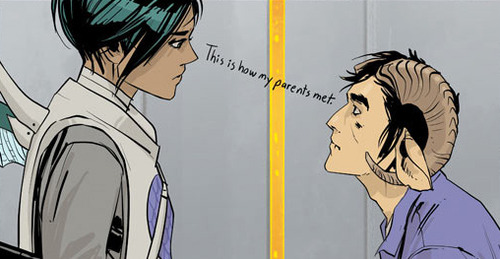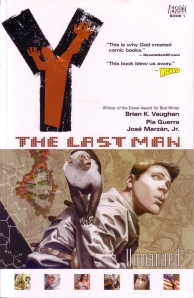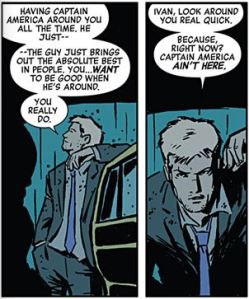My last contract has finished and now I’m unemployed for the first time in forever. DO YOU KNOW WHAT THIS MEANS?! Yep. I can fill my days with literally anything that takes my fancy. A person with that amount of free time learns a thing or two about themselves pretty quick. Here’s mine:
1. If I am not contractually obligated to be somewhere before 1pm, I am incapable of getting out of bed before 1pm.
2. I am a huge geek.
The reason for point two is simple. In all this spare time, I’ve done nothing that you would consider especially productive. Except realise I’ve ignored the comic book medium for far too long.
So I’ve done my research, the clerks at every comic book store in my fair city are starting to recognise me, and the good news is this:
There is literally a whole world of new, engaging and amazing stories out there waiting for you, if you’re prepared to leave all of your preconceptions behind.
Pile them all up in the centre of a square blanket, add a few bricks for weight, tie the corners of the blanket together and toss the whole bundle in the nearest body of water. Being narrow-minded never did anybody any favours.
There, doesn’t that feel better? You should be excited, really, you should be. There are a lot of incredible narratives and characters and worlds at your fingertips now, just waiting for you to dive in.
But it’s a slippery slope, a winding labyrinth, a deep and dark rabbit hole. Most DC or Marvel comics have a thousand (not quite) incarnations and almost as many story arcs within each, and they often overlap, so you need to read one before you read the other, or maybe you don’t, and what if you don’t like it, can you pick a different starting point or are there spoilers in the one you’ve already chosen? What’s the difference between Ultimate Spider-Man and The Amazing Spider-Man? Does it matter?
You’d be forgiven for quitting while you’re ahead, except you won’t, because now you’re more open-minded, right? Now you know that this will be worth it. Besides, there are rules to this. None more important than the Golden Rule.
Comic books aren’t all about superheroes.
If there’s a Silver Rule, it would have to be: The comics publishing industry is infinitely wider that DC and Marvel.
I can’t stress this enough. Not that it matters, because there are a slew of terrific narratives within the decades of superhero comic volumes lining shelves (and we’re being open-minded, remember?), but the days of buying a comic book meaning a choice between The Phantom and Superman are long gone. They’re so far gone it’s embarrassing.
Some of these, most people would’ve heard of. The Walking Dead, Neil Gaiman’s Sandman, Hellboy. But there’s more to it than that. A lot more.
Here’s an important third point (the Bronze Rule?): DC and Marvel aren’t just making superhero comics these days. They’re trying to get in on the markets cornered by top-quality indie publishers like Image or IDW by publishing more original content.
Before you decide you “don’t do” comics, here are five you need to read:
1. Saga, by Brian K. Vaughan (writer) and Fiona Staples (art).
It’s not fair of me to start here, and I’m sorry. I’m sorry for setting you up for disappointment, because after you read the first issue of Image Comics and you realise comic books are incredible because they’re like a movie had a baby with a book, and you can’t believe it took you this long to give reading them a try, you’ll go out and look for more just like Saga. And you’re not going to find anything, because Saga is well and truly in a league of its own.

It’s an epic space opera about Marko and Alana, who live on opposite sides of a wartorn part of the galaxy – she’s a soldier of the Landfall Caolition, on the universe’s largest planet, while he serves the forces of its only satellite moon, Wreath. When they have a baby together, the various powers that be are appalled at the unprecedented coupling and its potential for troop morale. Wreath hires various contract “freelancers” and Landfall charges Prince Robot IV, who has only just returned home from the war front, to track down and eliminate the young family. Narrating the whole affair is their daughter, Hazel.
The story sounds obvious enough, but Vaughan – an industry legend akin to The Walking Dead’s Robert Kirkman – is second to none when it comes to writing three-dimensional characters we can sympathise and empathise with. Plus, it’s hilarious. I laugh harder reading Saga than I do with any given episode of television. Oh, and there’s Fiona Staples’ beautiful art, which is beyond the limitations of my vocabulary.
2. Chew, by John Layman (writer/letterer) and Rob Guillory (art/colours)

“Meet Tony Chu. Tony Chu is almost always hungry, and almost never eats. Here’s why:
Tony Chu is Cibopathic. That means he can take a bite of an apple, and get a feeling in his head about what tree it grew from […] Or he could eat a hamburger, and flash onto something else entirely.
Strangely enough, the only food Tony Chu can eat and not get a psychic sensation from is beets. Consequently, Tony Chu eats a lot of beets.”
So begins Chapter One of this multi-award-winning, extremely weird and super wonderful story about Philly PD cop-turned-FDA agent Chu, and his unlikely non-superpower. It’s absurd and awesome, one-third gritty cop drama, one-third satire, one-third horror flick. And there’s a laugh on every page.

3. Y: The Last Man, by Brian K. Vaughan (writer) and Pia Guerra (art)
If you’ve read the above two and you still don’t think comic books can be taken seriously, at least read vol. 1 of the series that won Vaughan an Eisner Award for Best Writer.
The premise is simple but rich and involving. In the summer of 2002, a mysterious plague destroys everything with a Y chromosome – man, child and animal, erased from the planet in a so-called “gendercide”. Except for Yorick Brown and his pet monkey Ampersand, that is. The remaining 52 per cent of the world’s population – all female – are left in the catastrophic aftermath, while Yorick just wants to get to Australia and find his girlfriend, Beth. It sounds like the beginning of an awful sitcom, but Y: The Last Man is an intriguing and thought-provoking examination of society and politics, not to mention a fascinating feminist text.
The story concluded in 2008 after sixty critically-acclaimed issues released across six years.
4. Hawkeye, by Matt Fraction (writer) and David Aja (art)
 “WHAT?!” I hear you yell. “You said comic books weren’t all about superheroes!” Well cool your beans, because I did say that, and I’m sticking true to my word. You know why? Because Hawkeye? Not so super. And the team of Fraction and Aja have created the runaway hit nobody saw coming by revelling in that fact 100 per cent.
“WHAT?!” I hear you yell. “You said comic books weren’t all about superheroes!” Well cool your beans, because I did say that, and I’m sticking true to my word. You know why? Because Hawkeye? Not so super. And the team of Fraction and Aja have created the runaway hit nobody saw coming by revelling in that fact 100 per cent.
This is a bare-bones, laid-back and occasionally almost (almost) bland story about an imperfect, average Joe who can’t usually get through the day without pissing somebody off one way or another. The sticking point though is Clint Barton is a little more than ordinary. He’s an Avenger. Sometimes. But as we’re told in Issue #1, this is about what he does when he’s not being an Avenger. Specifically it’s about him trying to be a good guy to the public at large, and also about him trying to be a good mentor to Kate Bishop (who Marvel fans will know succeeds Barton as Hawkeye, eventually, in that part of the Marvel universe).
The only mission Barton’s concerned with is defending the tenants of his building from the Russian mobsters currently extorting them by, you know, buying it. Forcefully. The dynamic between the well-meaning Barton and infinitely more capable Bishop is reason alone to give this series a go, but this is also a solid lesson in how well the right minds can recreate a character you thought you knew from the ground up (starting to understand why there are so many versions of Spider-Man, now?).
5. Maus, by Art Spiegelman (writer and art)
The other four are warm-ups; Maus is some serious territory. It’s probably a terrible introduction for somebody new to comics, in all fairness, but it’s also one of the most awarded, critically-acclaimed graphic novels of all time, and also one that demonstrates beautifully the power of the medium.

Essentially, it’s Speigelman’s biography of his father, a Polish Jew imprisoned in Auschwitz by the Nazis. In Spiegelman’s rendering, the Nazis are depicted as cats and the Jews as mice. It’s a simple and devastating little book which in 1992 earned its creator an Eisner Award, Harvey Award, and Pulitzer Prize.